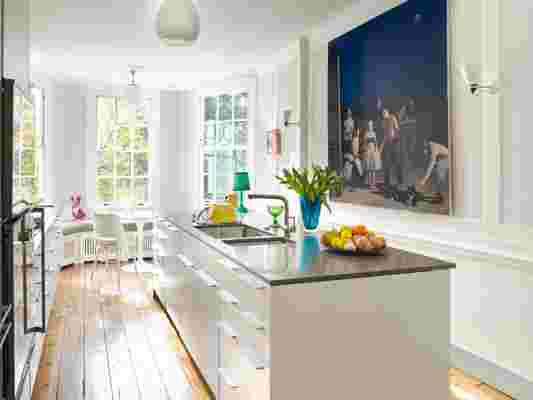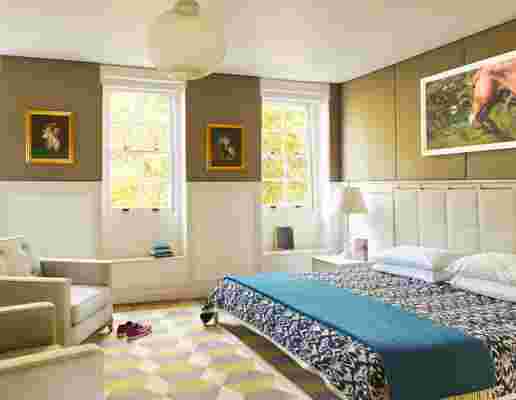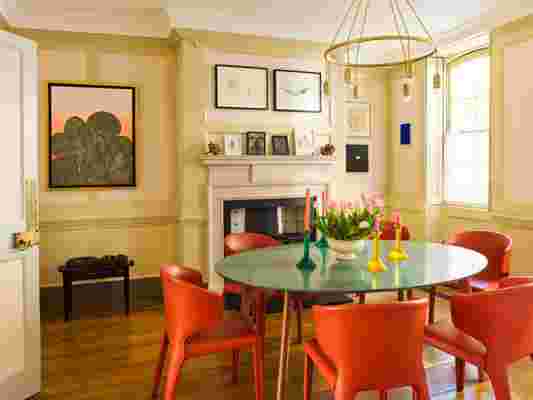England is a country where the sense of history can hang a little heavy on certain homeowners. Rules abound regarding what is and isn’t appropriate to the age of one’s residence—especially here in Hampstead, a beloved London “village” with a rich cultural past and present. None of this seems to trouble American architect, interior designer, and educator Bruce Irwin. “I think it’s all right to break the rules, if you do it with love,” he says of his home, a five-story Georgian terrace built in 1735 on one of the area’s loveliest streets, where he lives with his husband, Pedro Font-Alba, another architect.
Their historic house, with its bold Pop-y vibe, feels fresh and fun, far from a museum piece. Fitting for a somewhat unconventional backstory: When some of Irwin’s clients—an American family whose plans changed during the final stages of the renovation—offered him the chance to move in, he turned them down. A few months later, when it was offered again, “I thought I’d better at least check with Pedro, or he might divorce me,” Irwin laughs. Given the couple’s proximity to the residence throughout the renovation, Irwin and Font-Alba felt at home right after moving in.

By moving the kitchen to the upper ground floor, overlooking the garden, Irwin has recentered this five-story home. To protect the room’s 18th-century paneling, the sleek white Bulthaup cabinets are mounted on a hidden steel frame. The large painting is by Spanish artist Javito Ruiz Perez while the lamp is by MK. The ceiling lights are vintage glass designs, from LASSCO. And the vintage chairs are from Howe London while the Saarinen dining table is from Aram.
At the beginning of the project, Irwin was unfazed by taking on a house that’s nearly 300 years old. “I love places with atmosphere and I was drawn to the scale, the peaceful neighborhood—and the wonderful clients,” he says. The house, which had been in the same family for the last century, was relatively untouched. “It was like a treasure chest,” he says, looking back.
With these pluses came minuses, partly because of the building’s Heritage Grade II listing. The prestigious status brings with it innumerable rules regarding what one can and can’t do on the premises, and drawn-out approval processes. Irwin used that extra time to educate himself, visiting Georgian buildings and meeting experts. “I had to learn enough to find the right people,” he says, “from structural engineers to traditional plasterers.”

In the master bedroom, where the paneling is relatively recent, Irwin used muted khaki linen on the upper walls to create a restful mood that cocoons its occupants. Above the bed hangs a photograph by Ecuadorian artist Oscar Santillan; the oil paintings by the windows are by Basque artist Joseba Eskubi. An elegant pair of club chairs from Somerville Scott perch on the Rug Company rug.
The lower ground floor was once the domain of the servants, with a kitchen and washing room, or “scullery.” Irwin recentered the home by moving the kitchen to the upper ground floor, where it now sits beside the dining room. To keep the inspectors happy, Irwin had the sleek white kitchen hung from a steel frame that sits just in front of the antique wood paneling. The kitchen move freed up the lower ground floor to become a guest suite—ideal for the couple’s many visiting friends—comprising a bathroom and steam sauna in one of the vaulted rooms that extend out under the road. The three upper floors are given over to a living room and study, a master bedroom suite, and more guest bedrooms at the top of the house.
Having visited many comparable buildings as part of his research, Irwin felt that conventional Georgian color schemes were too dark and oppressive for this project. Knowing that the owners liked Scandinavian style, he took inspiration from the soft pastel tones of the Swedish Gustavian era. “It’s a similar period to this house, with a light and summery feel,” he says. Irwin wanted the furniture to be functional and resilient, so he opted for reissues of 20th-century design classics, with tubular metal and leather upholstery as recurring themes—and lots of bright color.

The couple’s main contribution as custodians of the house is arguably their art collection. Both are passionate about emerging Spanish art: “We’re drawn to pieces that have a strong aesthetic, whether that’s through color, geometry, or materials—and a powerful political agenda too.” Indeed, the provocative art collection—and the homeowners themselves—have breathed new life into these centuries-old rooms.
